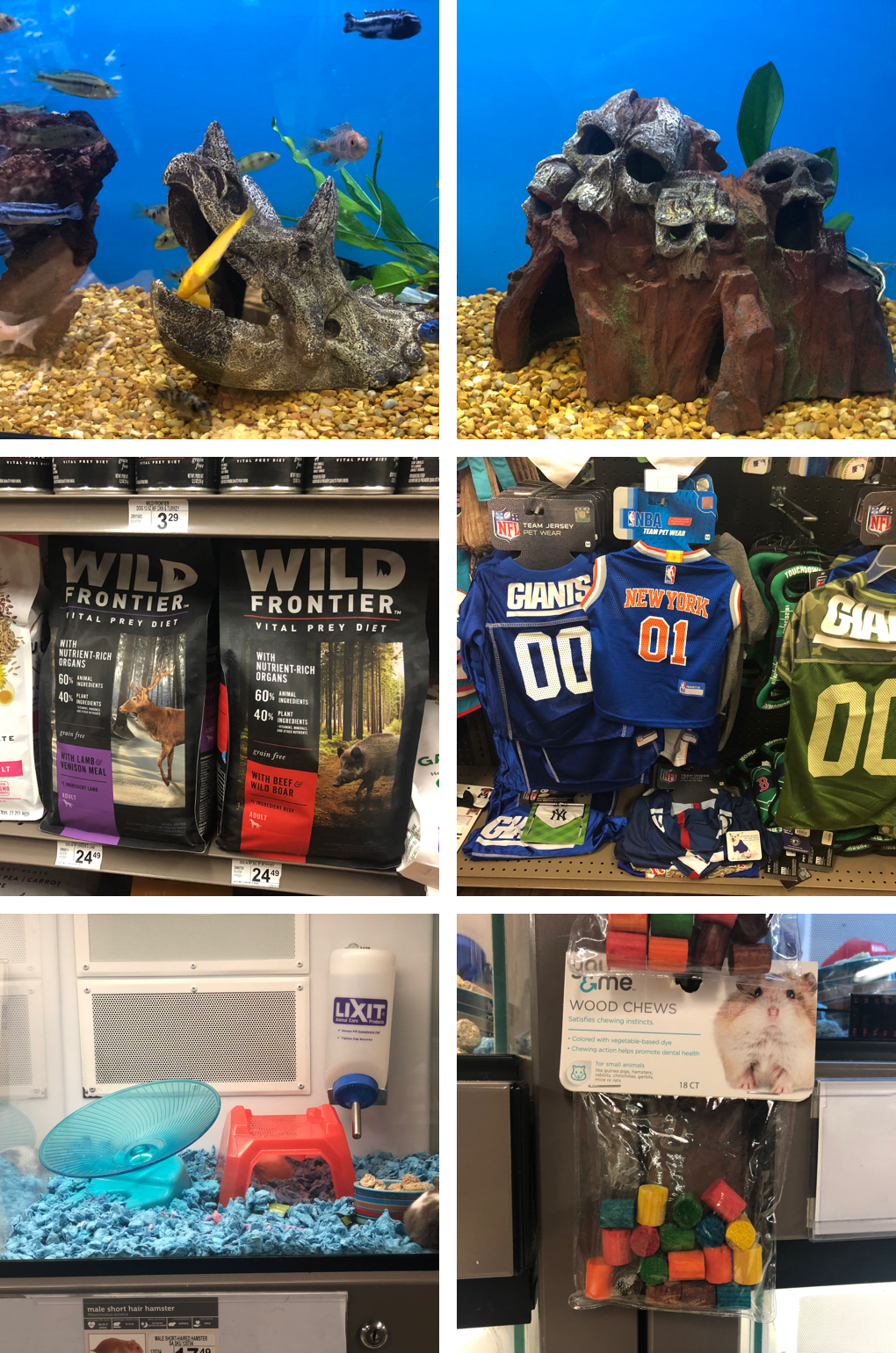
Assignment 4: Store Survey - Petco
05 March 2019
About Petco
Petco is the leading pet specialty retailer in the United States and delivers health and experiences for pets and their guardians. Petco’s mission is to provide products, services, advice and experiences that keep pets physically fit, mentally alert, socially engaged and emotionally happy. We took a visit to Petco, wanting to learn and know more about the environment Petco is building for the store-kept animals as well as the products they are selling, which ideally are supposed to enhance the animal-human relationship. During our visit to the Petco branch at Union Square in NYC, we had the chance to get a tour by a Pet Specialist named Kaylah, who showed us around the shop and its facilities. We were introduced to different pets like fish, rodents, reptiles and to the utility tools that are used to handle or feed these pets.
What are the tools used to interact with animals at these places?
1. Feeding
- General behaviors across all animals: offering food and refilling the food/water bowls/bottles Tools.
- Fish/Aquarium: Petco pet specialists use plastic cups to release the food like shrimps into the tanks.
- Reptiles: Specialists would feed the snake frozen mice instead of living ones because live ones can potentially bite and hurt the snakes; They also give live insects and worms to the lizards.
2. Capturing / Holding tools
- Aquarium: specialists use fishnet to capture fish. They use plastic bags to bag or release the fish.
- Birds: bare-hand sometimes. Since birds bite, they use gloves too.
- Guinea pigs: bare hands.
- Rodents: bare hands or sometimes with gloves.
- Reptiles: hands except for the snake
3. Environment
- High use of plastics in the fish tanks (Microplastic, could cause harm to the animals).
- Neon colors/color varieties.
- Human-centric design when it comes to the form of products used in the enclosures.
- Environmental Artifacts.
- Temperature and humidification monitoring.
- Fiji rock in every single aquarium.
4. Enrichment
- Hamster: running wheels.
- Parakeet: modular branches, wooden ladders, stringy chain.
Which products are human-centric vs animal-centric and why?
1. Human-Centric
- The design of the Décor for the fish tanks is mainly human-centric. It might have a positive effect on the animals (offering an opportunity to rest/hide) but it’s there to enrich the visual experience of humans.
- 'Organic' and 'Wild Animal' food products.
- Animal outfits.
2. Animal-Centric and Human/Animal-Centric
- Chewing toys increases the health of the animal (but very colorful).
- Ladder and branches for the parrots.
- Running wheels for the hamsters.
- Basic shelters or shades for all pets.

How would you reassess/redesign some of these products?
We were told that often time the employees get bitten by the birds when they try to take them out. They’d use gloves, but it still wouldn’t fix the issue fundamentally. Parrots bite out of their instinct–fear or distrust of the person who is holding them. It’d be nice if there would be a better design for the transition between them being on a branch and a human hand holding them. Maybe the glove material can be improved or a specific sensory stimulus can be applied in order to comfort the parrot and don’t get them as fearful. When it comes to the color, we think it’s important to analyze how these animals would react to certain colors and how much they can see. Overall, the color assortment at Petco is purely for human-pleasure and potential buyers.
How can some of the products in the stores, farms be relevant to animals in the urban wild?
Get wild” food – ironically it’s supposed to deliver a message that animals can be wilder if they eat the food. However, such a marketing strategy seems very unrealistic as a wild type of meat as food doesn’t really make a domestic animal change its behavior utterly. We saw in each of the aquarium tanks, there’s a big rock formation in the center. We asked the pet specialist at the store if it’s meant to imitate the real ocean environment where fish would have rocks and coral reefs to swim through, and we got an answer: “It’s for the look.” We noticed there are algae growing on the rock, which is a good sign as algae are very beneficial for the ecosystem that these fish are living in. However, the person at the store told us, even if these are good for the fish, the store employees would scrap them off because they don’t look visually pleasing.
Self-reflection
After visiting Petco for the first time in my life, I wonder if Petco is in the business of selling products that actually enrich animal’s lives or rather providing people with products that satisfy their human needs as well as their anthropomorphic views and attitudes towards their pets. It is always difficult to make a generalized statement and, of course, Petco also offers products that have been developed exclusively to enrich the lives of animals; a good example of this are the spinning wheels for rodents, which serve to satisfy the animals' urge to exercise. Nevertheless, I was amazed at how many products are indeed designed to meet the basic needs of animals, but also to appeal to people, mostly visually. Petco is not a place for animals or a place where products are provided exclusively for animals. Rather, Petco offers its customers the opportunity to shape the life and environment of their animals according to their own human standards and needs - perhaps that is why Petco is so successful. However, Petco and the industry it represents, fail to live up to the credo of our course of developing products from an animal's point of view.